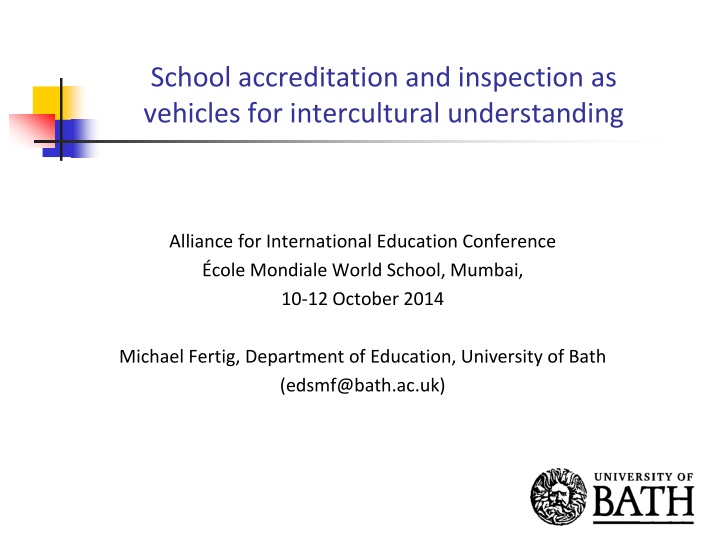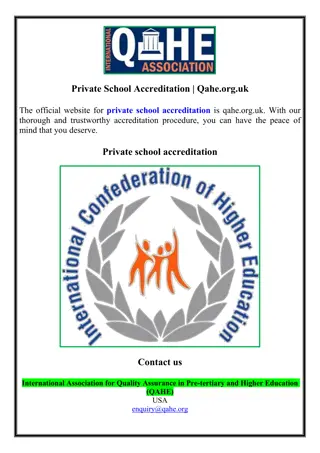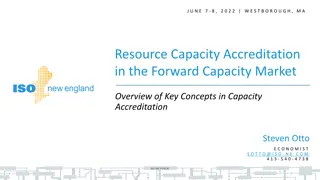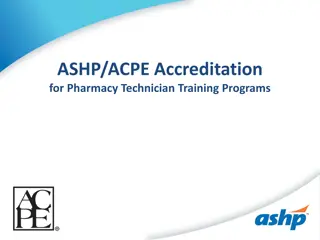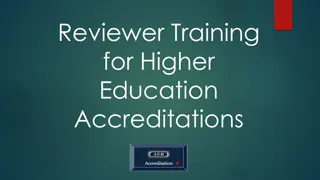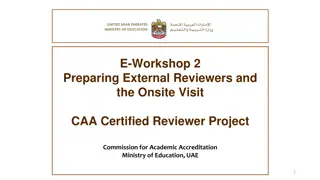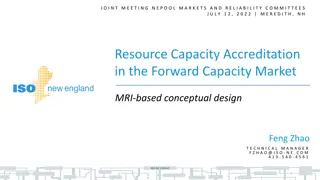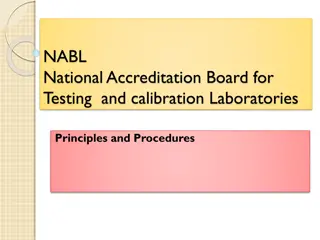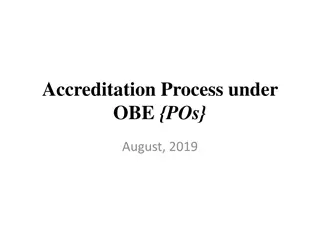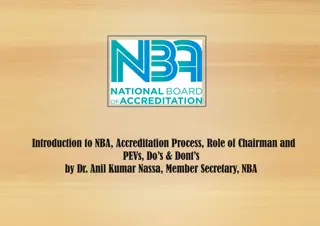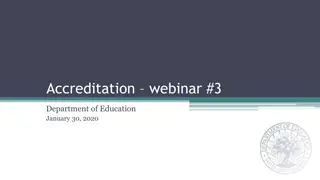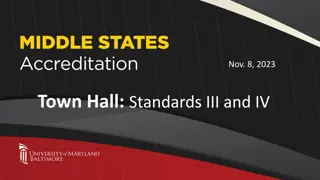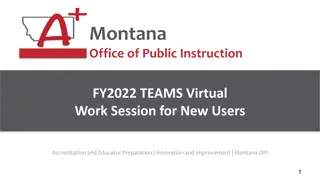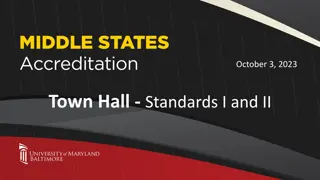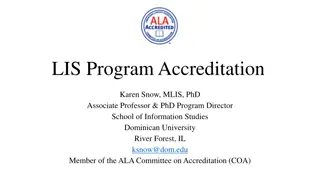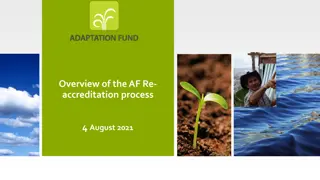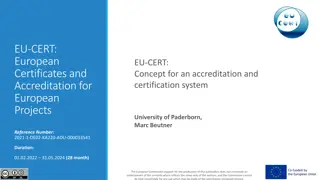School Accreditation: A Key Aspect in Education
School accreditation is a vital process that evaluates academic standards, learning experiences, and overall quality in educational institutions. It serves as a symbol of quality, ensures accountability, and stimulates institutional development and improvement. Accredited schools play a significant role in providing quality education globally. The interest in accreditation has been growing steadily, reflecting its importance in ensuring efficient use of resources and care for students. This article discusses the role of accreditation in fostering intercultural understanding and enhancing education quality.
Download Presentation

Please find below an Image/Link to download the presentation.
The content on the website is provided AS IS for your information and personal use only. It may not be sold, licensed, or shared on other websites without obtaining consent from the author.If you encounter any issues during the download, it is possible that the publisher has removed the file from their server.
You are allowed to download the files provided on this website for personal or commercial use, subject to the condition that they are used lawfully. All files are the property of their respective owners.
The content on the website is provided AS IS for your information and personal use only. It may not be sold, licensed, or shared on other websites without obtaining consent from the author.
E N D
Presentation Transcript
School accreditation and inspection as vehicles for intercultural understanding Alliance for International Education Conference cole Mondiale World School, Mumbai, 10-12 October 2014 Michael Fertig, Department of Education, University of Bath (edsmf@bath.ac.uk)
Accreditation 1. By accreditation we mean a public and independent affirmation of the academic standards of (such) institutions, and of the quality of the learning experience of the students who attend them (Alderman & Brown, 2005, p 314). 2. [within national education systems] evaluation of schools performance is conducted to provide satisfactory evidence to parents and to the wider community that they use taxpayers money efficiently and that they care for their students (Kyriakides & Campbell, 2004, p 24). 3. a symbol of quality in education (Southern Association of Colleges and Schools, 2004, p 1).
Interest in Accreditation Google hits 2007 4,220,000 446,000 2014 20,600,000 385,000 accreditation school accreditation
Interest in Accreditation Google Scholar hits 2007 15,400 2013 22,200 accreditation in title school accreditation in title 106 195
Accredited Schools Council of International Schools, Accredited Schools, July 2013: 398 Council of International Schools, location of Accredited Schools, July 2013: 94 countries [Council of International Schools (2013) International Schools Directory Accredited Schools. Council of International Schools, Leiden, The Netherlands.]
Accreditation Accreditation can be seen as part of a developing evidence-based governance regime (Ehren et al, 2013, p 4) within institutions. This is characterised by: a setting of expectations for the performance of educational organisations, and a clearer communication of these expectations an increasing use of evaluation and accountability as key issues to ensure quality provision for all a belief that evidence from evaluation and accountability processes will stimulate institutional (and system) development and improvement.
School Improvement a systematic, sustained effort aimed at change in learning conditions and other related internal conditions in one or more schools, with the ultimate aim of accomplishing educational aims more effectively . [van Velzen W., Miles M., Elholm M., Hamayer U. & Robin D. (1985) Making school improvement work: a conceptual guide to practice. ACCO, Leuven.]
Accreditation Process the rock of self-study the hard place of standards
Self-study Accurate self-evaluation is a pre-condition for school improvement. Without it, leaders do not have a realistic view of their school s strengths and weaknesses (Knowledge & Human Development Authority, 2012, Inspection Handbook 2012- 2013, p 6). Self-evaluation as an iterative, reflexive and continuous process, embedded in the culture of the school is a highly effective means for a school to consolidate success and secure improvement across the full range of its activities (Children, Schools & Families Committee, 2010, para 53). The key contribution of inspection to improving educational provision is to supply well-founded information about the performance of schools that can be used to increase parental choice and bring about positive changes (Knowledge & Human Development Authority, 2012, Inspection Handbook 2012-2013, p 61).
Self-study: emerging issues 1 The value assumptions reflect an ideology of self-evaluation particularly related to the fact that schools as organisations are predicated upon a moral order which typically involves commitment to fairness, consistency, an ethic of care and inclusion, as well as learning. This is because schools are primarily organisations in which the process of learning embodies value judgements about how people, especially young people, should be treated (Kyriakides & Campbell, 2004, p 25). [Findings based on the inspection of 143 private schools October 2012-April 2013] Currently, the quality of self-evaluation varies significantly between schools and school types, with around half of the schools demonstrating good or better self-evaluation, and the same proportion showing acceptable or unsatisfactory self-evaluation The accuracy of self-evaluation is impeded by low levels of expertise among school leaders, by a lack of understanding among teachers of what constitutes effective teaching and good learning, by support or pressure from owners and by the lack of international experience in best practice (Knowledge & Human Development Authority, 2012b, p 17). The analysis and the solutions would be generated from within the school, rather then being imposed on the school It would integrate the processes of research into the daily life of teachers and other staff, providing greater opportunities for best practice to be discussed and shared (Park, 2013, p 18).
Self-study: emerging issues 2 SAIS schools are asked to choose a method of evaluation that most closely aligns with the regular, on-going visioning or planning under way at the school A school can use any self study method generally recognized in the independent school world Choosing your own path is one of the distinctive features of the SAIS accreditation process (SAIS, 2013, p 17). Can the inward-looking approach signified by the self-study be maintained in market conditions that demand that international schools attest to a high degree of transparent accountability in order to attract increasingly discriminating customers (Fertig, 2007, p 339)? How central is the Self-study to school improvement? Might the self-study process stimulate new forms of cooperation, collegial, but also between academics, administrators and students, where practice with respect to teaching and learning is discussed, tested and contested (Stensaker, 2008, p 5)?
Standards & Intercultural Understanding Standard A2: The school s Guiding Statements shall clearly demonstrate a commitment to internationalism/inter-culturalism in education, and this shall be reflected throughout the life of the institution. Standard A3: The school s Vision for Students (or similar) shall demonstrate a clear commitment to fostering desirable traits related to internationalism/inter-culturalism, and this shall impact upon all students Standard B1: The curriculum, in its content, design, implementation, assessment and review, shall reflect the school s mission, learning objectives, and policies, and shall foster global citizenship and student achievement Standard B4: Students shall benefit from a curriculum and related activities that shall be enhanced by the cultural diversity of both the host country and the school community, hence contributing to the development of global citizenship in students. [Council for International Schools (2013) Standards for Accreditation Version 8.1]
Five pillars of International Education exposure to others of different cultures within the school teachers as exemplars of international mindedness exposure to others of different cultures outside the school a balanced formal curriculum a management regime whose values are consistent with an institutional international philosophy [Adapted from Thompson J. (1998) Towards a model for International Education in Hayden M. & Thompson J. (1998) International Education: Principles & Practice.]
Standards: Emerging Issues 1 ...highly structured organizational fields provide a context in which individual efforts to deal rationally with uncertainty and constraint often lead, in the aggregate, to homogeneity in structure, culture, and output (DiMaggio & Powell, 1983, p 147). Uncertainty is a powerful force that encourages imitation...Organizations tend to model themselves after similar organizations in their field that they perceive to be more legitimate or successful (DiMaggio & Powell, 1983, p 151-152). Expanding organizations shopping for new domains to occupy or new structures to add are forced by pressures for conformity to adopt structures that have the support and endorsement of key agencies in the institutional environment Educational innovations tend to gain legitimacy and acceptance on the basis of social evaluation, such as the endorsement of legislatures or professional agencies (Rowan, 1982, p 260). Despite the emphasis on self-evaluation and autonomy involved in most quality assurance models, (they) contain the risk of encouraging compliance to that standard set of criteria and, hence, to uniformity and homogeneity (van Damme, 2000, p 15).
Standards: Emerging Issues 2 institutional isomorphism promotes the success and survival of organizations. Incorporating externally legitimated formal structures increases the commitment of internal participants and external constituents. And the use of external assessment criteria that is, moving toward the status in society of a sub-unit rather than an independent system can enable an organization to remain successful by social definition, buffering it from failure (Meyer & Rowan, 1977, p 349). ...such a view of school accountability assumes that targeting the school unit will generate the desired changes in the individuals within that unit...(and) also assumes that it is possible to use external control to improve internal operations (Ng, 2010, p 280).
Further reading Alderman G. & Brown R. (2005) Can Quality Assurance Survive the Market? Accreditation and Audit at the Crossroads . Higher Education Quarterly. Vol 59 No 4 pp 313-328. Barrow M. (1999) Quality-management systems and dramaturgical compliance . Quality in Higher Education. Vol 5 No 1 pp 27-36. Children, Schools & Families Committee (2010) School Accountability. The Stationery Office, London. Coffey K.R. & Milsaps E.M. (2005) A handbook to guide educational institutions through the accreditation process. Edwin Mellen Press, USA. Council of International Schools (2003) School Improvement through Accreditation: Guide to School Evaluation and Accreditation 7thEdition. Council of International Schools, Petersfield. Crosbie V. (2014) Capabilities for intercultural dialogue . Language & Intercultural Communication. Vol 14 No 1 pp 91-107. van Damme D. (2000) Internationalization and quality assurance: towards worldwide accreditation . European Journal of Education Law & Policy. Vol 4 pp 1-20. Devos G. & Verhoeven J.C. (2003) School self-evaluation: conditions and caveats . Educational Management & Administration. Vol 31 No 4 pp 402 420. DiMaggio P.J. & Powell W.W. (1983) The iron cage revisited: institutional isomorphism and collective rationality in organizational fields . American Sociological Review. Vol 48 pp 147-160. Ehren M.C.M., Altrichter H., McNamara G. & O Hara J. (2013) Impact of school inspections on improvement of schools describing assumptions on causal mechanisms in six European countries . Educational Assessment, Evaluation & Accountability. Vol 25 pp 3-43. Fertig M. (2007) International school accreditation: between a rock and a hard place? Journal of Research in International Education. Vol 6 No 3 pp 333-348. Gundara J.S. & Sharma N. (2013) Some issues for cooperative learning and intercultural education . Intercultural Education. Vol 24 No 3 pp 237 250. Harwood R. & Bailey K. (2012) Defining and evaluating international-mindedness in a school context . International Schools Journal. Vol XXXI No 2 pp 77-86. Hayden M. & Thompson J.J. (1998) International Education: Principles and Practice. Kogan Page, London. Hill I. (2012) Evolution of education for international mindedness . Journal of Research in International Education. Vol 11 No 3 pp 245-261. Kay M. (2006) The effect of the New England Association of Schools & Colleges Accreditation process, including self-study, on teacher work activity. MA Dissertation, University of Bath, Bath.
Further reading van Kemenade E. & Hardjono T.W. (2010) A Critique of the Use of Self-evaluation in a Compulsory Accreditation System . Quality in Higher Education. Vol 16 No 3 pp 257-268. Knowledge & Human Development Authority (2012a) Inspection Handbook 2012-2013. Knowledge & Human Development Authority, Dubai. Knowledge & Human Development Authority (2012b) Inspection of Private Schools 2012-2013. Knowledge & Human Development Authority, Dubai. Kyriakides L. & Campbell R.J. (2004) School self-evaluation and school improvement: a critique of values and procedures . Studies in Educational Evaluation. Vol 30 pp 23-36. Lai C., Shum M.S.K. & Zhang B. (2014) International mindedness in an Asian context: the case of the International Baccalaureate in Hong Kong . Educational Research. Vol 56 No 1 pp 77-96. Meyer J.W. & Rowan B. (1977) Institutionalized Organizations: Formal Structures as Myth and Ceremony . American Journal of Sociology. Vol 83 No 2 pp 340-363. Ng P.T. (2010) The evolution and nature of school accountability in the Singapore education system . Educational Assessment, Evaluation & Accountability. Vol 22 pp 275-292. Park J. (2013) Detoxifying School Accountability. Demos, London. Perry L.B. & Southwell L. (2011) Developing intercultural understanding and skills: models and approaches . Intercultural Education. Vol 22 No 6 pp 453-466. Rowan B. (1982) Organizational Structure and the Institutional Environment: the Case of Public Schools . Administrative Science Quarterly. Vol 27 pp 259-279. Southern Association of Colleges & Schools (2004) Benefits of Accreditation. SACS, Decatur GA. Southern Association of Independent Schools (SAIS) (2013) Accreditation Guidebook. Atlanta GA. Stensaker B. (2008) Outcomes of quality assurance: a discussion of knowledge, methodology and validity . Quality in Higher Education. Vol 14 No 1 pp 3-13. Walton J., Paradies Y., Priest N. Wertheim E.H. & Freeman E. (2014) Fostering intercultural understanding through secondary school experiences of cultural immersion . International Journal of Qualitative Studies in Education. Accessed at http://dx.doi.org/10.1080/09518398.2014.891772
